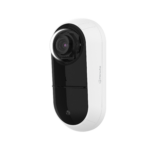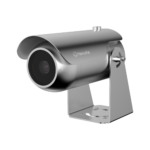2024.11.22
The Strategic Advantages of AI Video Surveillance in Auto Manufacturing

Auto manufacturers are increasingly investing in AI-powered video surveillance systems to create smarter and safer factories.
Along with enhancing security, these technologies are being utilized to boost productivity within manufacturing plants, minimize equipment downtime, and streamline compliance monitoring and reporting.
Managing External & Internal Threats
To prevent intruders and properly safeguard their facilities, companies need to optimize their perimeter security.
Essential elements of this strategy include selecting and positioning the right cameras, integrating IP audio solutions, establishing laser fence lines, and utilizing effective Video Management Systems (VMS).
The ultimate objective is to establish multiple layers of protection and ensure comprehensive coverage of the exterior, allowing security professionals to monitor everything in real-time from any location, whether on-site or remote.
By investing in high-performance, intelligent cameras, manufacturers can effectively cover. More with Less, ensuring full area coverage without blind spots. This can help also reduce costs by limiting the number of cameras needed to install, maintain, and operate. Ideal camera options for exceptional perimeter protection include:
- Hanwha Vision’s bi-spectrum thermal cameras that can accurately detect people, vehicles, and temperature variations, even in complete darkness.
- High-resolution 4K AI cameras that can precisely identify humans and vehicles, making them perfect for parking lots, entrances, exits, and other critical areas.
- License Plate Recognition (LPR) cameras that provide accurate license plate identification to restrict unauthorized vehicle access.
- Pan Tilt Zoom (PTZ) multi-sensor cameras that ensure complete coverage of perimeter areas and parking lots, featuring automated object detection and the ability to easily identify and track vehicles and individuals.
Protecting Critical Data from Internal Threats
Auto manufacturers must diligently safeguard their intellectual property. Exposing proprietary information, such as prototype data, engineering and design plans, long-term strategies, or research findings, can severely damage a company’s reputation, competitiveness, and relationships with partners and suppliers.
In addition to maintaining a robust cybersecurity posture, manufacturers can further mitigate risks by deploying effective AI video surveillance solutions to monitor and secure all entryways, executive centers, IT facilities, research labs, and any other locations housing critical company data.

Again, selecting and correctly positioning a suitable mix of AI-enabled cameras and IP audio systems is crucial. Smart choices include 360° fisheye cameras for comprehensive coverage of lobbies, hallways, and offices, as well as PTZ and multisensor cameras equipped with license-free AI analytics and Best Shot features, enabling tracking of visitors and employees from entry through the entire facility.

Maximizing Equipment Uptime & Reducing Environmental Risk
Unplanned downtime can cost manufacturing plants between 5–20% of their annual productivity, according to The International Society of Automation.
Today’s advanced AI-enabled video surveillance solutions can play a crucial role in reducing downtime.
For critical machinery—such as broaching, drilling, laser cutting, welding machines, and conveyor belts—AI radiometric thermal cameras are ideal for ensuring that safe temperature operating limits are maintained.

Temperature fluctuations often serve as early indicators of existing or potential equipment issues. If overheating is detected, production supervisors are promptly alerted, allowing them to conduct necessary preventive maintenance before more costly breakdowns or environmental hazards, such as fires or leaks, occur. Having early and detailed insights into temperature changes can also prompt manufacturers to reassess their current maintenance practices.
For instance, there may be a need to increase the frequency of component checks or adjust the intervals between fluid changes (such as lubricants or greases).
Quality Control & Workflow Optimization
By combining visual information and AI data analytics, manufacturers can quickly detect any bottlenecks in assembly lines, or anomalies or defects that may occur in the production process. This ensures that the highest product quality standards can be maintained, and any problems are immediately addressed.
This information can also reveal various workload stresses and challenges that may negatively impact production lines, including employee fatigue and errors, equipment issues, or unsafe material handling.
With robots increasingly integrated into auto production for tasks like painting, welding, assembly, and material handling, AI video surveillance can precisely identify robot-related challenges. While it’s easy to envision robots operating flawlessly, this is not always the reality.
According to a report from the International Journal of Performability Engineering, robot system failures occur approximately 12% of the time each year, caused by a variety of issues.
By analyzing continuous data from sensors, AI-enabled video surveillance can help prevent specific robots from becoming overloaded, reducing wear and tear on their components, and decreasing the risk of failure or downtime.
A Safer Factory Floor
Properly positioned AI surveillance cameras enable manufacturers to identify realtime workplace hazards such as slip-and-fall incidents, improper lifting of heavy objects, handling of hazardous materials, and employees neglecting to wear Personal Protective Equipment (PPE).
Another significant issue affecting workplace safety across every manufacturing industry is unsafe forklift operations. In many regions, forklifts are involved in over 5% of serious workplace injuries and more than 10% of related fatalities.
New sophisticated AI applications are being developed and integrated into intelligent surveillance cameras. These advanced solutions assist manufacturers in better protecting employees and significantly reducing forklift-related accidents, compliance violations, and costly legal repercussions.
For example, Hanwha Vision recently launched a Smart Factory solution set that combines established video surveillance technologies with proprietary software and AI analytics to monitor all aspects of forklift operations.
If a driver exceeds designated safe forklift speed limits, they receive an immediate notification and warning to slow down. Similar alerts are triggered if a forklift is improperly parked. Additionally, valuable Proximity Detection notifications ensure a safe distance is always maintained between personnel and forklifts, between multiple forklifts, or between a forklift and equipment or structures such as tall shelving units.
Simplify Compliance Reporting
Reporting on compliance with essential maintenance, operational, and sustainability regulations is crucial for successful manufacturers. However, the process is often very time-consuming.
Automated reports generated by AI-enabled video surveillance systems can help manufacturers accurately evaluate their team’s compliance with industry and safety standards, reducing the time and resources spent on compliance reporting. With this data, companies can more accurately assess the effectiveness of their current compliance and safety training initiatives and identify areas for improvement.
CLOSE
In today’s highly competitive automotive industry, manufacturers need every advantage they can get. Investing in the right AI-enabled video surveillance systems is just one of the ways that they can enhance productivity and safeguard their people, data, and facilities.


